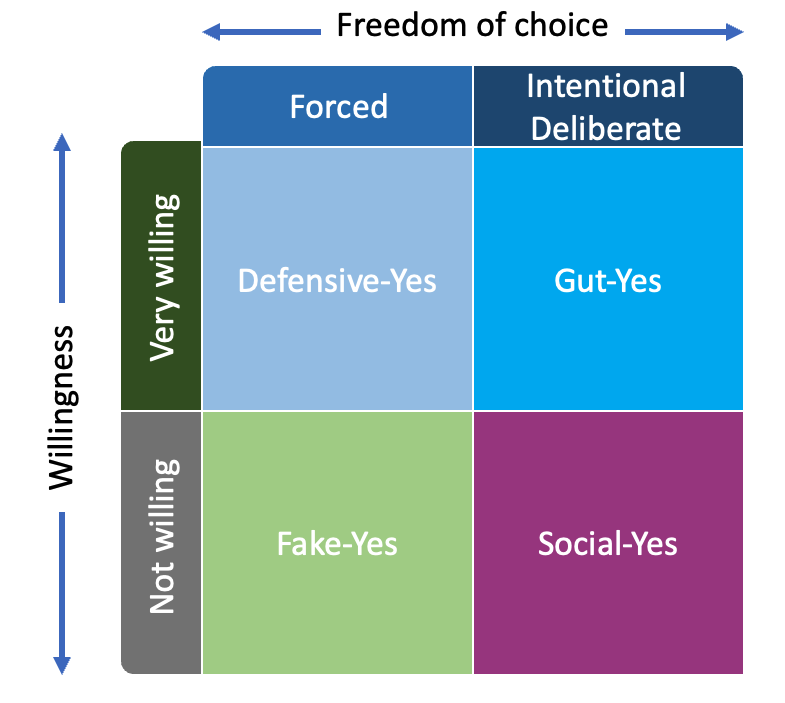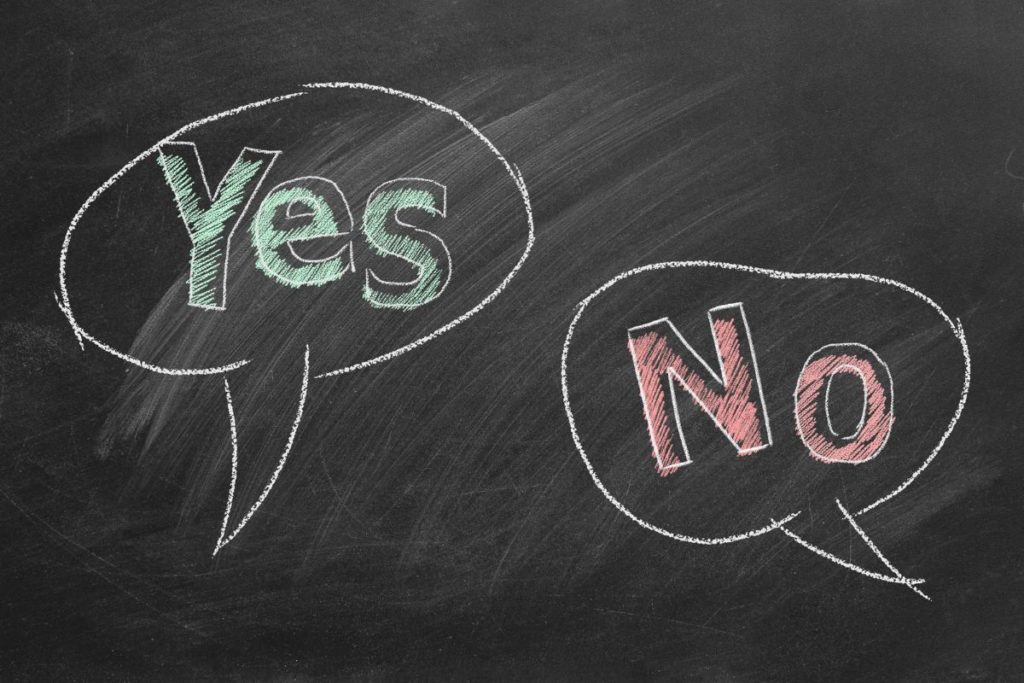One of the most valuable things in business and life is trust. Trust is hard to earn but can be easily lost. As a consultant, I have encountered issues related to trust and its effects on business. Specifically, I’ve witnessed the remarkable impact of saying “yes” in business on cultivating and maintaining trust. I have observed how confidence can affect business and life, and I’ve come to a significant realization: in most cases, people who kept their word earned trust. People tend to say YES to those they trust, and this correlation between trust and saying “yes” is undeniable.
What does it mean to say YES?
We use the word YES to approve if something said is accurate or correct. YES comes from the Old English word gise, gese, which means “so be it!”
There are many ways to convey the sense of YES. Some of the synonyms include: definitely, of course, sure, by all means, that’s right, you bet, you’re on, affirmative, be my guest, I don’t see why not, yea, yeah, yebo, yep, you betcha, yup, is the Pope Catholic?
The meaning we give to a YES varies. Saying YES after long and arduous peace negotiations or at your wedding doesn’t have the same significance and importance as answering YES to the question: “Are you hot?” These nuances are the origin of many interpersonal difficulties. Let us look at the different types of yeses below.
Types of YES
Saying YES does not necessarily mean we agree on something. Some factors determine the type of YES we are likely to receive or speak to someone—the word YES can be said deliberately or coerced. When YES is forced, there will be no willingness to follow up on the YES, which can be detrimental. A YES should be intentional and contain a desire to carry through what has been agreed upon.
Looking deeper into the process of saying YES to something, the degree of freedom of choice, the intentionality, willingness, circumstances, and surroundings when deciding to say YES play an essential role in the type of YES. These factors form the basis of the four variations of yeses:
- The Gut-Yes
- The Social-Yes
- The Defensive-Yes
- The Fake-Yes
Below is a pictorial representation of the variations of YES.

From the image above, the horizontal axis goes from a YES said under total external pressure, no natural choice, to a YES expressed when you are free to do so, and it is your own choice.
The vertical axis goes from being 100% willing to make what we have said YES to a reality (total commitment) to zero willingness to comply with what we have agreed to.
Let’s look at what these types of yeses mean.
The Gut-Yes
The Gut-Yes corresponds to the YES, that is entirely deliberate. The person is then unquestionably willing to bring what they are saying YES to into existence. We have a conscious decision or choice, an expression of total agreement about the subject. In other words, the person wants what he agrees to.
The Gut-Yes contains part of the magic that propels us to do more. It pushes us to stretch and get out of our comfort zone. It gives us hope, opens us to discoveries, and forces us to create and seize opportunities. Giving a Gut-Yes to something bigger than us is an excellent opportunity to demonstrate our skills. In most cases, a Gut-Yes helps us grow and develop new competencies.
When we accomplish a Gut-Yes, we create trust between the involved parties:
- The person we said YES to concludes that we are trustable and reliable.
- We prove to ourselves that we can fulfill the promise and keep our word. Such a situation boosts self-confidence and prepares us to take on more challenges next time and carry them through.
It may be sometimes scary to give a Gut- Yes, but the excitement and the magic it contains are more significant and more rewarding.
The Social-Yes
The Social-Yes is a deliberate YES, but that doesn’t necessarily mean the person saying it has the intention to comply with it. It is used automatically in a conversation to acknowledge the other person. We use a Social-Yes to let the speaker know that we are listening to what they are saying or to encourage them to continue with the idea. It is an excellent way to tell the other person that their opinions count.
The Social-Yes has a considerable value in regular communication. It makes us better listeners. Even if, at the end of the conversation, you may reject the person’s idea, the Social-Yes helps someone acquire new ideas and understand what the others have in their mind. The social yeses could ultimately lead to a Gut-Yes when people later think through the ideas discussed during a conversation.
Social-Yeses do not have any commitment or obligation as the Gut-Yeses. Africans have an expression that describes very well this level of YES. “Speaking in one’s mouth” describes someone who says things lightly and never accomplishes them. They promise something, but there are only words, and they are not committed to them.
The Defensive-Yes
The Defensive-Yes is the YES voiced in situations where saying yes is the only option. The freedom of choice is taken away during such instances. Imagine a situation where you are ambushed in a sales conversation with a pushy salesperson who gives you no way out. You may end up saying YES to get out of the unpleasant conversation. You may disagree with the situation but must say YES to get away from the case. It is a YES, but it has been shoved down your throat.
The Fake-Yes
The Fake-Yes is a YES that is said for the sake of saying YES. It is always a lie because the person saying it has no intention of doing anything to follow up the YES. We also have a form of cowardice here because the person telling a Fake-Yes just didn’t dare to say NO.
The difference between the Fake-Yes and the Defensive-Yes is that there is no external pressure in this case. A Fake-Yes intends to lie or to deceive. It is said because it suits our personal “interest” primarily at that moment.
Looking at the types of YES, you will agree that the Gut-Yes is the most viable and acceptable type of YES. The three others strain trust and, ultimately, a relationship between the receiver and the one saying the YES because when they are told, they are not followed through.
The Defensive-Yes and Fake-Yes are primarily used in situations where the appropriate answer would have been a NO. This highlights the importance of the ability to say NO. To learn more about the ability to speak NO and its advantages, Read the blog article “Why intelligent use of NO is your most powerful tool to success.”

How to be in control of your YES in any situation
Saying YES cannot be underestimated. It’s a process that must be well thought out for the YES to mean something. Mastering this process can open many doors and put you in a position for more extraordinary achievements, as external factors won’t be able to influence your YES. Let’s look at the process of mastering the use of the different types of YES.
Giving a Gut-Yes
When you say a Gut-Yes, there is little that can stop you if you have very high dedication and commitment. You are armed to overcome any adversity on the way, and you will accomplish what you said a YES to. In the worst-case scenario, if you have done everything possible, including asking for help, and fail to achieve the agreed task, you must review the situation and the old agreement. This will help to maintain the trust, and you can together come up with a new decision to which you may YES or NO and move forward. Master giving Gut-Yeses opens room for developing a confident and positive attitude.
“If someone offers you an amazing opportunity and you are unsure you can do it, say yes. Then learn how to do it later.” – Richard Branson
Giving a Social-Yes
The Social-Yes can be used to expand perspectives and gather data. Since giving a Social-Yes doesn’t equate to agreeing with others, it can be used to get more information about something. Always be open to ideas but keep your judgment.
For example, in a brainstorming session, you can listen to all ideas and collect as much data as you need, but at the end of the conversation, make sure you clarify and validate only the Gut-Yeses.
Giving a Defensive-Yes
When you find yourself in a situation where you are forced to say YES, as soon as possible, get back to the person who caused you to say YES and renegotiate. If it is impossible to reason with the other party, you can seek a mediator to help you sort it out. If you cannot manage and feel forced to do something that does not align with who you are, you must resign and get yourself out of this situation. Your integrity is more valuable than anything else. Saying YES and eventually failing to honor the agreement will lead to a loss of trust.
Sometimes the Defensive-Yes changes to a Gut-Yes. For instance, you can be in a particular emotional condition when you say YES, which can make you feel like you have been forced to say YES. If you take time to review the context and change your viewpoint, you can be deliberately willing to do what was asked. If this happens, then your Defensive-Yes has changed to a Gut-Yes. After completing the mission, it may be necessary to sit down with the person who forced the YES on you to handle the emotional part to avoid similar situations in the future.
Giving a Fake-Yes
This is the YES we should always avoid because it lowers our self-esteem and makes us lose trust completely. We may have many excuses to give this type of YES, but we should resist and prefer saying NO. In these situations, it takes courage, self-respect, and honesty to say NO instead of YES. But each time you avoid saying a Fake-Yes, you will be proud of yourself and boost your self-esteem.
How to be in control when receiving a YES from somebody
When we are at the receiving end, receiving the Gut-Yes is as important as saying the Gut-Yes. Understanding the types of yeses puts us in a pole position to filter and gauge the kind of YES we are receiving. It is the duty and responsibility of the person receiving the, YES, to check the nature of it and make sure they accept only the Gut-Yeses.
Generally, we have a passive attitude when receiving a YES. In a cause-and-effect relationship, we welcome a YES in the effects end.
“Yes, I will finance your project.”
“Yes, you are hired.”
“Yes, I want to marry you.”
“Yes, I see what you mean.”
Keeping a passive mindset for the different shades of yeses is dangerous. It opens the door to frustrations and disappointments. In the end, you will find yourself with comments like: “I thought you said YES!” because you failed to judge its type.
Below are some insights on handling the different levels of yeses we receive.
Receiving a Gut-Yes
When receiving a Gut-Yes, you are supposed to be happy and not passive. It would be best to do the following to ensure it is a valid Gut-Yes.
- Acknowledge it
- Reformulate it if needed to ensure the person saying YES understands what they are getting into.
- Put it in writing to avoid statements like “This is not what I said,” “Where is it written?” or “If it is not in writing, it is not true,” especially when they are not able to follow through with the YES. Not everything should lead to a formal contract, but taking notes of the agreements is a good practice. In a professional context, a simple meeting minute or email that recap what has been agreed upon is an excellent way to formalize a Gut-Yes.
- Clarify with them how and what they are going to do by going through the process with them again
- Offer your help if the person is facing difficulties when implementing the agreement.
- Agree on how you are going to follow up and the timelines. It is not because somebody said they are going to do something by the end of the month that you should wait until the end to find out what was done. You can agree to meet weekly for an update on the progress or just a simple weekly email update. This way, you are still in control of getting it done.
- You should make sure the other person respects his YES. You are responsible for ensuring what has been promised to you is accomplished. Many underestimate this aspect of an agreement or find it unpleasant to follow up; nevertheless, it is vital. If you are good at this, you won’t blame others for not keeping their promises. They said YES to you; make sure they are committed to their end of the bargain.
Following the above insight, you can develop your ability to accept Gut-Yes and steer clear of the levels of yeses. Always be a Sherlock Holmes with the yeses thrown at you; trust your gut feeling. Challenge any YES said to you until you are sure it is a Gut-Yeses. Avoid signing a blank cheque on a YES.
Receiving a Social-Yes
Receiving this type of YES is tricky because you cannot hold them accountable when someone uses it. When you detect that someone is giving a Social-Yes, make sure you use it to your advantage to ensure the person saying it to you gets all the information they need. Ask them questions and provide more data to allow them to see the consequences and the effort required to accomplish what they are socially saying YES to. Discuss the pros and cons of the issue at hand. By challenging your interlocutor this way, he may move his YES to a Gut-Yes or say a clear NO. In such cases, the clear NO is much better than the Social-Yes because you will have no expectations from the interlocuter, which gives you a clear view of a way forward. It helps you avoid many problems and frustrations for you and the interlocutor.
Receiving a Defensive-Yes
A defensive YES shouts wrong in all angles for both parties: you and the interlocutor. If you are receiving a Defensive-Yes, it means you have created the condition to accept it, and the interlocutor didn’t have freedom of choice. To avoid receiving this type of YES, you should not put people in a situation where they feel obliged to say YES to you. Ensure the surrounding conditions are not uncomfortable to them and create a positive and neutral environment to ensure the YES is not told from understanding. By not making the conditions favorable, you risk a Defensive-Yes, which is unproductive.
Confronting the person’s unwillingness and respecting that is a step in the right direction to handle such a situation. You can challenge the person by asking questions to discover why they are reluctant, but you should not push it through because it suits you and ignores what they want.
In the case of a sale, for example, the person can reject the contract after signing it, never buy from you another time, or even never pay you the money.
It is better to face the fact the person is not willing and voluntarily says NO to the situation instead of forcing the other to say YES. A Defensive-Yes leads to frustrations for all ends: the receiver and the giver.
Receiving a Fake-Yes
This is the worse type of YES that you can receive from someone. It holds no commitment and has not always been thought through, which makes it worse. It can lead to a lot of frustration for the receiver. That’s why you need to detect a Fake-Yes before accepting it. Whenever you have the impression that you have received one, question it hard. Don’t stay in doubt. Ensure you examine the person thoroughly because this YES never leads to any positive action.
If you don’t have a clear answer after questioning them, you must take the lead and say NO, to avoid disappointment later. Knowing the people you are dealing with can help when fact-checking if you are getting a Fake-Yes. If you blindly accept a YES from somebody you know is unreliable, you are setting yourself up for failure.
“Whoever is careless with the truth in small matters cannot be trusted with important matters.” – Albert Einstein
When it comes to saying YES or Receiving a YES, we have seen that you must remain in the driver’s seat—not being in control when on either end is a recipe for disaster. You should take responsibility in both cases (giver or receiver) if you are to make any positive strides and achieve great things.
Can you imagine how healthy a relationship would be if both parties took responsibility? Each side would be committed to having Gut-Yeses, which leads to trust, fulfilled promises, and outstanding achievements.

Conclusion:
Mastering the YES principles takes some practice. With training, observation, and trusting your judgment, you can become an expert in reaching Gut-Yeses. You will know who you can trust, which can be a game changer in life or business. The more you give Gut-Yeses to others, the easier it will be for you to control the yeses you receive.
The power of YES complements the power of NO. You must master both subjects if you want to remain in the driver’s seat in your life and business.
Practice and train yourself to give Gut-Yeses and master the process of receiving Gut-Yeses and let us know how it works for you!




